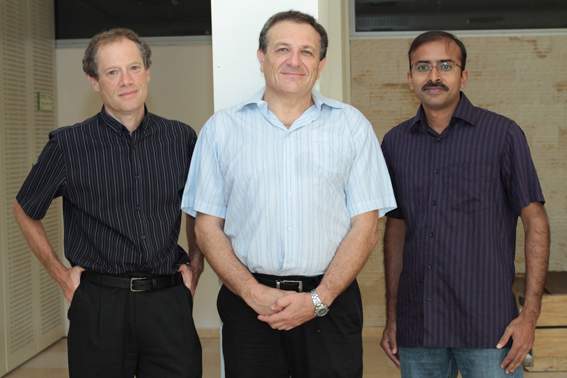
“In the everyday world, energy must be directly pumped into an object if we want to heat it. But for such quantum-sized objects as atoms or atomic nuclei, all one has to do is ‘take their temperature’,” says
Prof. Gershon Kurizki of the Institute’s Chemical Physics Department in the Faculty of Chemistry. Recently, Kurizki and
Prof. Lucio Frydman of the same department demonstrated this principle. The results of their
experiment may, in the future, lead to new applications in magnetic resonance, as well as open new ways of storing information.
In 2008, Kurizki and his colleagues Noam Erez and Goren Gordon predicted in an
article appearing in
Nature that measuring certain quantum systems could coax them into more- or less-ordered states. (The more ordered a system, the colder one can say it is.) This prediction was based on a fundamental effect of quantum physics: Many consecutive measurements or observations will change the system. The key, according to Kurizki’s research, is in the timing – how frequently these measurements are repeated. Extremely frequent measurements, for example, might heat a system up, whereas slightly slower rates could cool it down.
This is where Frydman, an experimental scientist who enjoys pushing the limits of nuclear magnetic resonance (NMR), came into the picture. Together with Kurizki and postdoctoral researchers Gonzalo Alvarez and D. D. Bhaktavatsala Rao, he came up with a way to test the prediction using NMR. “NMR turns out to be an ideal technology for conducting such experiments. The long radio waves it employs make it many times slower and often much more accurate than what is feasible with other methods,” says Frydman. “This gives us a great level of control.”
Kurizki’s work was based on an open quantum system: one in which a small ensemble of quantum particles interacts with a surrounding “bath” consisting of many particles. Just as a normal-sized object and a bath of water in which it is placed will exchange heat, eventually causing their temperatures to equalize, quantum objects in a particle bath tend to reach an equilibrium point with their surroundings. On the quantum level, that equilibrium may entail more than balancing heat: It can involve changes in certain quantum characteristics, for instance, in the intrinsic angular momentum carried by many atomic nuclei – a property called spin. Particle spins that are ordered – i.e., aligned with one another – will resemble a system that has been “cooled”; less-ordered, more random spin arrangements will make the system appear “hotter.” According to Kurizki’s prediction, measurements can disrupt the equilibration between the quantum ensemble and its bath, a finding that contradicts the expectations of classical thermodynamics. In other words, measurements can effectively free the particles from some of their bath’s influence, allowing one to “reset” their temperature.
In the experiment assayed by this team, the bath was composed of a large number of protons (hydrogen nuclei), while the quantum particles consisted of scattered 13C nuclei associated with carbon atoms. To mimic the measurement process, the scientists applied short magnetic pulses and, as they did so, they looked at the alignment of the 13C spins. Initially, these nuclei were in a disordered state, with their spins pointing every which way. But using varied timing for the magnetic pulses – at the rate of about one to ten per millisecond – the spins could be lined up parallel or anti-parallel to the magnetic field. “It’s like a person wandering back and forth along a path,” says Frydman. “By deciding when and where we stop him, thus ‘resetting’ his walk, we control where he ends up. With our experimental system, we found that we could align groups of quantum particles’ spins ‘upwards’ or ‘downwards’ by this approach – and in certain instances end up obtaining higher alignments than those achievable by other methods for manipulating such systems.”
The scientists were surprised at the extent to which the experimental results matched the theory, and they have begun to envision possible applications. Frydman, for instance, believes that a method for controlling the spins of quantum particles could increase the effectiveness of certain NMR and MRI experiments. Kurizki, meanwhile, intends to investigate how the principle could help overcome one of the stumbling blocks to building quantum computers. “To create a quantum memory register,” he says, “one needs to begin with all the particles’ spins aligned in the same direction. Our method could do this with minimal ‘brute force’. Generating the necessary order might be as simple as finding the right timing for the repeating of a measurement.”
Prof. Lucio Frydman's research is supported by the Ilse Katz Institute for Material Sciences and Magnetic Resonance Research; the Helen and Martin Kimmel Award for Innovative Investigation; the Helen and Martin Kimmel Institute for Magnetic Resonance Research, which he heads; the Fritz Haber Center for Physical Chemistry, which he heads; the Willner Family Leadership Institute for the Weizmann Institute of Science; the estate of Hilda Jacoby-Schaerf; and the estate of Lela London.
